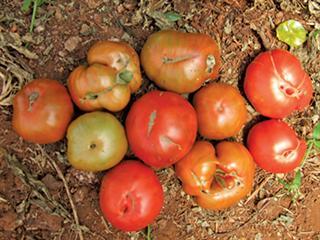
One is catface. This is an ugly, misshapen, scarred fruit. It can be caused by various factors, chief among them being when the flower adheres to the developing fruit and causes these ‘distortions’. Catface is usually a problem in wet conditions, which makes it easier for the remains of the spent flower to stick to the fruit. For the same reason, it’s also far more common on fruit closer to the ground, as this area is wetter than higher up the plant, and the lower leaves touching the ground then trap humidity in this area.
Trimming
In order to reduce the potential for damage, some farmers trim off the lower leaves to improve ventilation. A further benefit of this practice is that this is the area where diseases start. By removing the vulnerable leaves and changing the microclimate, you can delay the onset of many diseases. Rounder tomatoes are less prone to catface as the flower residue slips off more easily due to the shape.
On the other hand, some varieties are far more prone to catface than others. So choose your tomato variety carefully, especially in more humid climates. Catface can also be caused by thrips damaging the embryo even before pollination has taken place. The thrips feed by rasping the tender skin of the tomato at this very early stage and may cause severe scars which become exaggerated as the fruit increases in size.
Calcium
Blossom end rot is another disorder which most tomato growers will have encountered at some stage. Here the blossom end becomes black or brown and ‘sunken’. This is dead tissue, and the disorder is caused by insufficient calcium. You may have had enough calcium in the soil before planting, but in some cases there might be increased sodium in the root zone if the irrigation water has some salinity, or it can be brought up from deeper soil layers by evaporation.
When the sodium level rises, the calcium percentage of the cations is reduced which means that the plant takes up less calcium. The problem will be exacerbated by applying excess nitrogen. This causes the calcium to be used in the rapidly growing foliage, especially in soil where the calcium levels are marginal. This condition can be brought on by allowing the plants to become too dry.
Very often there’s no problem until we slip up with irrigation and suddenly we lose a fair percentage of our crop in one go.
With adequate calcium, this same dry spell may cause no damage. There are also varietal differences in resistance to blossom end rot. Ensure that the soil’s calcium levels are adequate before planting. Don’t take a chance. Too much is at stake. In any case, calcium helps provide a better quality tomato. You can apply suitable calcium foliar feeds if the symptoms start to manifest.
Cracking
Cracking is another physiological problem which can render the fruit unmarketable. There are basically two types of cracks. Radial cracks, which encircle the fruit, and stem end cracks. Radial cracks are the result of uneven growth of the fruit which is usually associated with alternating wet and dry conditions. They’re essentially stress cracks. Although water levels play a role in both types of crack, stem end cracks are a bigger varietal problem. The onset of a prolonged wet period can induce more cracking, especially if the plants were on the dry side before this occurrence.
Sunburn
Another hazard is sunburn, especially when the fruit is suddenly exposed to strong sunlight due to leaves being broken or moved while harvesting. Also, this might be stating the obvious, but allowing tomatoes to stand in the sun in their boxes after picking can do a lot of damage far more quickly than most realise.
Contact Bill Kerr at [email protected]. Please state ‘Vegetable production’ in the subject line of your email.













